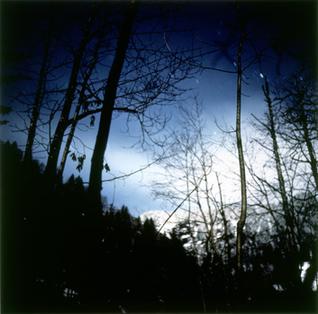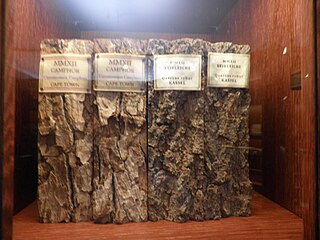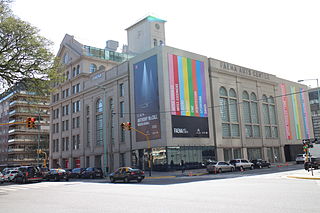
Marc Quinn is a British contemporary visual artist whose work includes sculpture, installation, and painting. Quinn explores "what it is to be human in the world today" through subjects including the body, genetics, identity, environment, and the media. His work has used materials that vary widely, from blood, bread and flowers, to marble and stainless steel. Quinn has been the subject of solo exhibitions at Sir John Soane's Museum, the Tate Gallery, National Portrait Gallery, Fondation Beyeler, Fondazione Prada, and South London Gallery. The artist was a notable member of the Young British Artists movement.

Olafur Eliasson is an Icelandic–Danish artist known for sculptured and large-scaled installation art employing elemental materials such as light, water, and air temperature to enhance the viewer's experience.

Darren James Almond is an English artist, based in London. He was nominated for the 2005 Turner Prize.

Doug Aitken is an American multidisciplinary artist. Aitken's body of work ranges from photography, print media, sculpture, and architectural interventions, to narrative films, sound, single and multi-channel video works, installations, and live performance. He currently lives in Venice, California, and New York City.
Mark Manders is a Dutch artist, currently living and working in Ronse, Belgium. His work consists mainly of installations, drawings and sculptures. He is probably best known for his large bronze figures that look like rough-hewn, wet or peeling clay. Typical of his work is also the arrangement of random objects, such as tables, chairs, light bulbs, blankets and dead animals.

Léviathan Thot is an art installation by the Brazilian artist, Ernesto Neto of 2006.
There were four nominees for the 2006 Turner Prize for British contemporary art, and the winner was Tomma Abts.

Mark Dion is an American conceptual artist best known for his use of scientific presentations in his installations. His work examines the manner in which prevalent ideologies and institutions influence our understanding of history, knowledge and the natural world. The job of the artist, according to him, is to "go against the grain of dominant culture, to challenge perception and convention". By locating the roots of environmental politics and public policy in the construction of knowledge about nature, Dion questions the objectivity and authoritative role of the scientific voice in contemporary society, tracking how pseudo-science, social agendas and ideology creep into public discourse and knowledge production. Some of his well known works include Neukom Vivarium (2006), a permanent outdoor installation and learning lab for the Olympic Sculpture Park in Seattle, Washington.
Tanya Bonakdar Gallery is an art gallery founded by Tanya Bonakdar, located in both Chelsea in New York City and Los Angeles. Since its inception in 1994, the gallery has exhibited new work by contemporary artists in all media, including painting, sculpture, installation, photography, and video. The New York City location is at 521 W. 21st Street and the Los Angeles gallery is located at 1010 N. Highland Avenue.

Shilpa Gupta is a contemporary Indian artist based in Mumbai, India. Gupta's artistic practise encompasses a wide range of mediums, including manipulated found objects, video art, interactive computer-based installations, and performance.

Faena Art Center is the cultural center of the Faena District Buenos Aires, a residential and cultural community in the Puerto Madero waterfront in Buenos Aires developed by the Faena Group and opened in September 2011. Alan Faena founded the center. Ximena Caminos is the Executive Director.
Liz Larner is an American installation artist and sculptor living and working in Los Angeles.
Analia Saban is a contemporary conceptual artist who was born in Buenos Aires, Argentina, but is currently living in Los Angeles, California, United States. Her work takes traditional artistic media such as drawing, painting and sculpture and pushes their limits as a scientific experimentation with art making. Because of her pushing the limits with different forms of art, Saban has taken the line that separated the different art forms and merged them together.
Sandra Cinto is a Brazilian contemporary artist, known for her sculpture, drawing, paintings, and installations. Born in Santo Andre, Brazil in 1968; Cinto is currently living and working in São Paulo, Brazil. Cinto's artwork mixes installations, paintings, and detailed pen drawings. Sandra Cinto continues to produce artwork and showcase her work.
Sabine Hornig is a German visual artist and photographer who lives and works in Berlin. Her work in photography, sculpture, and site-specific installation art is known for her interpretations of modernist architecture and contemporary urban life. Her work has appeared in solo exhibitions throughout the world, including Double Transparency at Art Unlimited Basel in Switzerland (2014) and Projects 78 at the Museum of Modern Art in New York (2003), and in numerous group exhibitions at institutions like the J.Paul Getty Museum in Los Angeles and ICA London.

Tomás Saraceno is an Argentine contemporary artist whose projects, consisting of floating sculptures, international collaborations, and interactive installations, propose and dialogue with forms of inhabiting and sensing the environment that have been suppressed in the Capitalocene era.
Agnieszka Kurant is a Polish interdisciplinary conceptual artist. She examines how economic, social, and cultural systems work in ways that blur the lines between reality and fiction.
Won Ju Lim is a Korean American artist. She currently divides her time between Los Angeles, CA and Boston, MA.
Nathalie Djurberg and Hans Berg are a Swedish-born artist duo. They have been working together since 2004.











